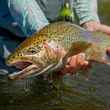If you don’t count any of the newly-added sticks in my vintage rod collection, it’s been a long time since I picked up a new-to-me rod that elicited an honest wow. The Orvis Helios 3D was the last rod I reviewed that made me think, I need one of these for myself, in a few different weights and lengths, just for good measure.
Then, a new Douglas Sky G 9’ 5wt showed up in the mail, and I have once again found myself trying to cook my books to find the money to add one to my quiver. This rod is special.
Like most new, flagship rods, it was built using bleeding-edge technology—in this case, what Douglas calls "G-Tec" platelets (tiny bits of graphene) added to the Sky G's resin matrix. If you're not familiar with Graphene, at ten times the strength of steel (but with only 5% of the density), graphene is one of the strongest materials known to man. In addition, and partially due to, its new technology, the Sky G also follows the recent design trend of a more minimalist build approach, in favor of putting more money into blank design and production. In other words, Douglas didn’t spend money trying to make the Sky G sexy, though I’m sure a lot of anglers will appreciate the rod’s muted, subtle craftsmanship.
What makes the Sky G stand out, though, is what the late Tom Morgan once told me all fly rods should do. Tom – who owned Winston and is responsible for them being in Montana – said that the best fly rods are the ones that fish the best. Never mind whether you can cast it to backing – a rod’s true measure lies in how it acts on the water. In that arena, the Sky G excels and separates itself from its peers.
So, what makes it that great? Let’s take a more detailed look.
What Works
Weight
The 9’ 5wt Sky G – currently the only configuration available, though 8 and 6wt models are on the way – clocks in at 2.7oz, according to the folks at Yellowstone Angler. It’s noticeably light in-hand and is lighter than any of the other rods in its class that I’ve fished. In fact, the Sky G is so light that I wondered how it would handle longer casts, heavier flies, and big fish. It accomplishes those tasks exceptionally well, with a weight-to-performance ratio reminiscent of early pre-IM6 and Fisher-rolled IM6 Winston graphite rods.
Action
This is where the Sky G struts its stuff. When giving it the ol’ fly shop wiggle, the rod flexes through its top third section, looking and feeling both like a faster-action rod. The minute you line it up, though, you realize the rod has a surprisingly pleasant, medium-fast action that loads deep in the middle of the blank. The quick recovery of the blank, though, ensures that the Sky G doesn’t enter the oft-maligned territory of a slow-action graphite rod.
What this all means is that in traditional trout distances – 15-40 feet – you have almost unmatched feel and command of your fly line. Since the rod loads so deep into the blank, you get more feedback to improve the timing of your casts. And, using that much of the blank to cast, coupled with its quick recovery, generates high line speeds and shocking amounts of power.
Or, in other words, I can throw a 15-foot leader with three dry flies out to 50 feet without using a double haul.
Power and Line Speed
I mentioned these above, but they merit their own section.
While fishing a midge hatch last week, I was throwing 60-70 foot casts (not because I needed to, mind you – I wanted to put the Sky G through its paces), letting them drift a few feet, then picking up anywhere from 45-55 feet of line. The goal was to see how much line I could pick up and cast in a single motion. And, unless I mistimed my cast, the Sky G picked up line at every distance I tried.
Add the line speed to that power, and you have a rod that will reach out and touch trout at any distance you want. Often, I’d finish my cast, only to have the line go taught against my reel’s drag. Flies zip through the air, delivered on time and on target.
Accuracy and Presentation
The issue that’s plagued faster-action rods has always been their presentation. Often, a faster action causes your fly line to hit the water with more force. That causes anglers to try and pull their cast a bit, hoping to soften a fly’s landing, and their accuracy decreases.
Lately, we’ve seen these issues addressed by most of the big rod makers. Douglas didn’t miss the memo, because the Sky G is both incredibly accurate, yet delivers flies with a subtle grace that’s often lacking in quicker sticks.
I had several other experience anglers spend time with the Sky G and each of them, unprompted, remarked on the rod’s accuracy.
What Doesn’t Work
Single-foot Guides
I’ve heard the argument in favor of single-foot guides – that fewer guides reduces weight, improves how a rod flexes, etc. And that may be true. But I like the security and look of a snake guide, and there’s no reason not to use them on an $800 rod.
Cork
This is a small thing, but I’d like to see higher-quality cork on the Sky G. The rod retails for $795, but still sports a grip bordered by burnt cork rings. In addition, the cork itself is noticeably a step below, quality wise, what you’ll find on other $800 rods.
Final Word
The Sky G is a fantastic rod. Douglas knocked it out of the park with this stick, and it’s one that’s already earned a permanent spot in my quiver. The rod’s smooth, unique action coupled with high line speed gives anglers extreme accuracy and power – useful for both long casts and big fish. I had no problem turning over long dry fly leaders, a dry-dropper-dropper rig, or streamers and sink tips. Its light weight, and sleek overall design will make this a hot seller in fly shops. Thanks to the moderate-fast action the Sky G offers, you’ll likely be hard-pressed to find a better rod for the 15-40 foot distance.
Now, I’m not in the business of saying that one rod is the “best” currently available. What’s best is simply too subjective to quantify.
What I will say, though, is that the Sky G has earned a spot amongst the top echelon of rods that I would recommend to anyone looking to buy a new, high-end fly rod. It’s a truly unique rod that deserves as much consideration as the latest offerings from more prominent names in the industry.
LEARN MORE ABOUT THE DOUGLAS SKY G (via Douglas Outdoors)
Spencer Durrant is a fly fishing writer, outdoors columnist, and novelist from Utah. Spencer’s work has appeared in multiple national publications, including Field & Stream, Gray’s Sporting Journal, Hatch Magazine, Trout Magazine, and others. Connect with him on Instagram/Twitter, @Spencer_Durrant.





























Comments
Evan replied on Permalink
So if I was going to spend $800+ on a rod, would you ultimately recommend the Sky G or Helios 3? (and which Helios 3, D or F)?
Pages